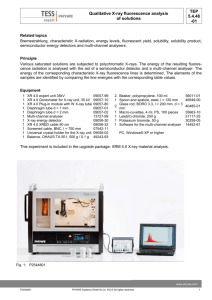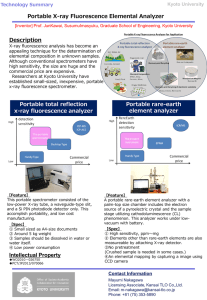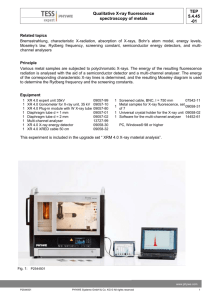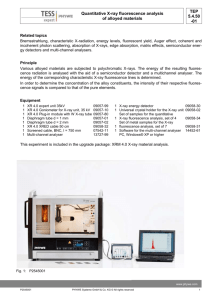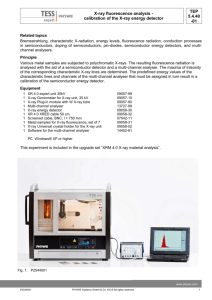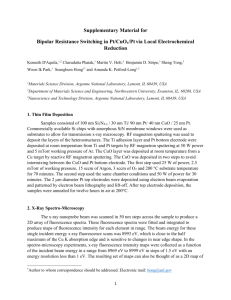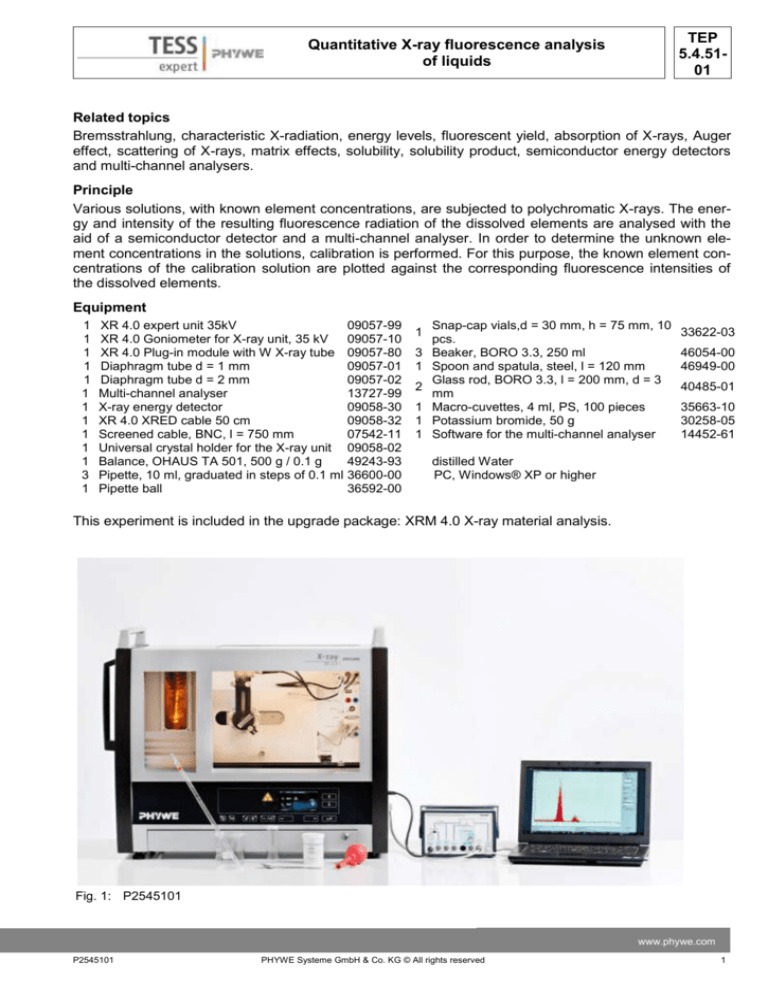
TEP
5.4.5101
Quantitative X-ray fluorescence analysis
of liquids
Related topics
Bremsstrahlung, characteristic X-radiation, energy levels, fluorescent yield, absorption of X-rays, Auger
effect, scattering of X-rays, matrix effects, solubility, solubility product, semiconductor energy detectors
and multi-channel analysers.
Principle
Various solutions, with known element concentrations, are subjected to polychromatic X-rays. The energy and intensity of the resulting fluorescence radiation of the dissolved elements are analysed with the
aid of a semiconductor detector and a multi-channel analyser. In order to determine the unknown element concentrations in the solutions, calibration is performed. For this purpose, the known element concentrations of the calibration solution are plotted against the corresponding fluorescence intensities of
the dissolved elements.
Equipment
1
1
1
1
1
1
1
1
1
1
1
3
1
XR 4.0 expert unit 35kV
09057-99
XR 4.0 Goniometer for X-ray unit, 35 kV 09057-10
XR 4.0 Plug-in module with W X-ray tube 09057-80
Diaphragm tube d = 1 mm
09057-01
Diaphragm tube d = 2 mm
09057-02
Multi-channel analyser
13727-99
X-ray energy detector
09058-30
XR 4.0 XRED cable 50 cm
09058-32
Screened cable, BNC, l = 750 mm
07542-11
Universal crystal holder for the X-ray unit 09058-02
Balance, OHAUS TA 501, 500 g / 0.1 g
49243-93
Pipette, 10 ml, graduated in steps of 0.1 ml 36600-00
Pipette ball
36592-00
1
3
1
2
1
1
1
Snap-cap vials,d = 30 mm, h = 75 mm, 10
pcs.
Beaker, BORO 3.3, 250 ml
Spoon and spatula, steel, l = 120 mm
Glass rod, BORO 3.3, l = 200 mm, d = 3
mm
Macro-cuvettes, 4 ml, PS, 100 pieces
Potassium bromide, 50 g
Software for the multi-channel analyser
33622-03
46054-00
46949-00
40485-01
35663-10
30258-05
14452-61
distilled Water
PC, Windows® XP or higher
This experiment is included in the upgrade package: XRM 4.0 X-ray material analysis.
Fig. 1: P2545101
www.phywe.com
P2545101
PHYWE Systeme GmbH & Co. KG © All rights reserved
1
TEP
5.4.5101
Quantitative X-ray fluorescence analysis
of liquids
Safety instructions
When handling chemicals, you should wear suitable
protective gloves, safety goggles, and suitable clothing. Please refer to the appendix for detailed safety
instructions.
Tasks
1. Calibrate the semiconductor energy detector
with the aid of the characteristic radiation of the
tungsten X-ray tube.
2. Record the fluorescence spectra of potassium
bromide solutions with various concentration
levels.
Fig. 2: Connections in the experimentation area
3. Determine the intensity of the characteristic
bromine radiation, based on the spectra.
4. Create a calibration function that is based on the
concentration values as well as the intensity of
the associated fluorescence radiation.
Note
Please comply with the relevant safety instructions
Fig. 3: Connection at the external panel of the XR 4.0 Xwhen handling and disposing chemicals.
ray expert unit to the MCA
X-ray energy
detector
Set-up
- Screw the adapter ring onto the inlet tube of the
energy detector.
- Connect the signal and supply cables to the corresponding ports of the detector with the aid of
the right-angle plugs.
Left position of the
- Connect the signal and supply cables from the
goniometer
MCA to the appropriate connections in the exUniversal crystal
periment chamber of the X-ray unit (signal caholder with filled cuble: red, supply cable: green (see Fig. 2)).
vette
- Connect the external ports for the X RED of the
x-ray unit (signal cable red, supply cable green,
see Fig. 3) to the multi-channel analyse (MCA).
Connect the signal cable via a screened BNCcable to the “Input” port of the MCA and the
supply cable to the “X-Ray Energy Det.” port of
the MCA.
- Secure the energy detector in the holder of the
swivel arm of the goniometer. Lay the two cables with sufficient length so that the goniometer Fig. 4: Set-up at the goniometer
2
PHYWE Systeme GmbH & Co. KG © All rights reserved
P2545101
Quantitative X-ray fluorescence analysis
of liquids
TEP
5.4.5101
can be swivelled freely over the entire swivelling range.
- Connect the multi-channel analyser and computer with the aid of the USB cable.
- Insert the tube with the 2-mm-aperture.
- Bring the goniometer block and the detector to
their respective end positions on the left. Bring
the detector to the 90° position in the 2:1 coupling mode (Fig. 4).
- .
Calibration of the multi-channel analyser
(if there is no other already existing calibration that Fig. 5: calibration of the multi-channel analyser
can be used)
- Bring the goniometer block and the detector to their respective end positions on the right.
- Insert the tube with the 1mm-aperture into the exit tube of the X-ray tube.
- With the X-ray unit switched on and the door locked, bring the detector to the 0° position. Then,
shift the detector by some tenths degree out of the zero position in order to reduce the total rate.
- Operating data of the tungsten X-ray tube: Select an anode voltage UA = 25 kV and an anode
current IA = 0.02 mA and confirm these values by pressing the “Enter” button.
- Switch on the X-radiation
- In the MEASURE program, select “Multi channel analyser” under “Gauge”. Then, select “Settings
and calibration”. After the “Calibrate” button has been clicked, a spectrum can be measured. The
counting rate should be < 300 c/s. Energy calibration settings: - 2-point calibration, - Unit = keV,
Gain = 2 – Set the offset so that low-energy noise signals will be suppressed (usually a few per
cent are sufficient), See Fig 5.
- Measuring time: 5 minutes. Use the timer of the X-ray unit.
- Make the two coloured calibration lines congruent with the line centres of the two characteristic
X-ray lines. The corresponding energy values (see e.g. P2544701) E(L3M5/L3M4) = 8,41 keV and
E(L2N4) = 9,69 keV are entered into the corresponding fields, depending on the colour. (Note:
Since a separation of the lines L3M5 and L3M4 Lines is not possible, the mean value of both lines
is entered as the energy of the line).
- Name and save the calibration.
Sample preparation
In order to perform two series of measurements, two parent solutions with different starting concentrations must be prepared.
Parent solution 1 (low KBr concentration): 10 g of KBr / 100 ml of distilled H2O.
Parent solution 2 (saturated KBr solution): approx. 65 g of KBr / 100 ml of distilled H2O.
Fill the weighed potassium bromide portions separately into beakers that have been filled with 100 ml of
water beforehand. Stir with the glass rod in order to completely dissolve the potassium bromide.
Now, prepare the diluted solutions based on parent solution 1. In order to prepare 10 ml in a defined
way, use one pipette for the water and one for the solution (attach the pipette ball alternately). The pipettes are calibrated for delivery. Fill the two liquids into a snap-cap vial. It is important to thoroughly mix
the new solution.
Fill a plastic cuvette to ¾ with the mixed solution.
For a second series of measurements, those solutions with lower concentration levels must be prepared
in the same way, only this time based on parent solution 2.
www.phywe.com
P2545101
PHYWE Systeme GmbH & Co. KG © All rights reserved
3
TEP
5.4.5101
Quantitative X-ray fluorescence analysis
of liquids
Spectrum recording
- Insert the tube with the 2mm-aperture.
- Bring the goniometer block and the detector to their respective end positions on the left.
- Bring the detector to the 90° position in the 2:1 coupling mode (the sample holder must then be
aligned to 45°).
- Fasten a filled plastic cuvette to the universal crystal holder with some double-sided adhesive tape so
that a flat side of the cuvette is hit by the primary beam of rays (See Fig 4).
- Operating data of the molybdenum X-ray tube: Adjust an anode voltage Ua = 35 kV and an anode
current ia = 1 mA (ia = 0.7 mA for the second series of measurements).
- Measuring time: 5 minutes (use the timer of the X-ray unit).
Evaluation of the measurement curves
- In order to determine the line energy, switch from the bar display to the curve display. To do so, click
“Display options” and then “Interpolation and straight lines”.
- Extend the relevant line section with the zoom function
-
Then, select the curve section with
. Open the window “Function fitting ”. Then, select “Scaled
normal distribution”.
Find the line centroid of the normal distribution with “Peak analysis” or determine it with the function
“Survey”
(see Fig. 3).
Theory and Evaluation
The X-ray fluorescence analysis is particularly suitable for determining the elements and their concentration levels in liquids. The method can be applied, for example, in order to determine the concentration
levels of heavy metals in sewage water.
In order to determine the concentration of the elements in a sample with the aid of X-ray fluorescence
analysis, a qualitative analysis must first be performed. During the assignment of the fluorescence lines,
it must be taken into consideration that the relaxations that follow the primary ionisation process can only
take place if they fulfil the quantum-mechanical selection rules Δj = 0, ±1 and Δl = ±1 (j = total angular
momentum, l = orbital angular momentum). In addition, it should be noted that every element has groups
of X-ray lines that have a certain intensity relation.
If, for example, one considers a specific line as the Kα line of an element, it should be possible to detect
the corresponding Kβ line in the correct intensity relation, provided that it is not overlaid by a line of another element. When the lines have been assigned to the elements, the line intensity allows for conclusions to be drawn about the concentration of the elements.
In general, matrix effects make it difficult to determine the concentration directly, since the fluorescence
radiation that is stimulated by the primary radiation is not only a function of the element concentration but
also of the element combination.
If one changes, for example, the solvent, then the fluorescence intensity of the element that is analysed
may differ even though the concentration is the same.
This is why, in practical applications, quantitative analysis is performed via a comparison with the calibration functions that are stored in the computer and that have been created with certified reference samples.
Task 2: Record the fluorescence spectra of potassium bromide solutions with various concentration levels.
Figure 6 shows the fluorescence spectrum of an aqueous potassium bromide solution. Based on the
4
PHYWE Systeme GmbH & Co. KG © All rights reserved
P2545101
Quantitative X-ray fluorescence analysis
of liquids
TEP
5.4.5101
characteristic fluorescence lines of potassium bromide, Figure 7 shows the method for
evaluating these curves.
Table 1 shows a comparison of the experimental energy values of the lines and the
corresponding table values.
The lines 1 (E = 7.5 keV) and 2 (E = 8.1
keV) are caused by nickel and copper. The
scattered primary radiation generates fluorescence radiation on the material compo1 2
3 4
5
nents of the detector housing. This fluores↓↓
↓ ↓
↓
cence radiation is also detected by the detector. Line 5 (E = 16.7 keV) can be assigned to the Compton-scattered primary
Mo-Kα-radiation. The energy of the charac- Fig. 6: Fluorescence spectrum of a potassium bromide
teristic fluorescence radiation of potassium
solution
is close to the sensitivity limit of the energy
detectors, which is why it cannot be identi-
Fig. 7: Zoomed representation with a fitted normal distribution of the Kα- and Kβ-lines of bromine
fied in this experiment due to the low concentration level.
Task 3: Determine the intensity of the characteristic bromine radiation, based on the spectra and Task 4:
Create a calibration function that is based on the concentration values as well as the intensity of the associated fluorescence radiation.
Figure 8 shows the linear course of the intensity of the Kα-line of bromine as a function of the bromine
concentration (with the background intensity taken into consideration) for a solution that is not too strongly concentrated (measurement series with parent solution 1). This calibration can now be used for determining the bromine concentration of other bromine solutions.
One cannot assume, however, that this calibration function can be used for all of the concentration lev-
www.phywe.com
P2545101
PHYWE Systeme GmbH & Co. KG © All rights reserved
5
TEP
5.4.5101
Quantitative X-ray fluorescence analysis
of liquids
els. As the evaluation of the corresponding measurement series with the saturated parent solution 2
shows (Fig. 9), the calibration functions only apply to a limited extent to liquids. In the case of strongly
saturated solutions, the linear relation between the intensity and concentration is disturbed by matrix effects.
Table 1: Energy of the fluorescence lines of bromine
Line
Eexp. / keV
Elit. / keV
11.90
11.92
3-Kα
Fig. 8: Calibration function of a KBr solution of a low concentration
4-
13.26
13.29
Kβ
Fig. 9: Calibration function of a KBr solution of a high concentration
6
PHYWE Systeme GmbH & Co. KG © All rights reserved
P2545101
Quantitative X-ray fluorescence analysis
of liquids
TEP
5.4.5101
Disposal
Do not dispose of heavy-metal-containing waste via household waste.
Appendix
Hazard symbol, signal word
Hazard statements
Precautionary statements
H315: Causes skin irritation
H319: Causes serious eye
irritation
H335: May cause respiratory irritation
P261: Avoid breathing
dust/fume/gas/mist/vapo
urs/spray.
P305 + P351 + P338: IF
IN EYES: Rinse cautiously with water for
several minutes. Remove contact lenses, if
present and easy to do.
Continue rinsing.
Potassium bromide (KBr)
www.phywe.com
P2545101
PHYWE Systeme GmbH & Co. KG © All rights reserved
7
TEP
5.4.5101
8
Quantitative X-ray fluorescence analysis
of liquids
PHYWE Systeme GmbH & Co. KG © All rights reserved
P2545101

